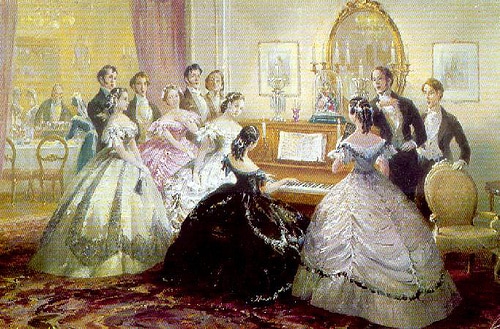Edited By Pauline Weston Thomas For Fashion-Era.com
This costume history page is about Medieval Hairstyles. It consists of a selection of women-only headdresses and hairstyle illustrations and text from 1066 to 1327 all taken from Calthrop's English Costume.
They are as shown in individual Calthrop costume pages for specific eras on 36 other pages in another section of this website. The partial text copy is from the book ENGLISH COSTUME PAINTED & DESCRIBED BY DION CLAYTON CALTHROP. Full text is on the individual dated pages.
This page is about female headdresses and hairdressing styles for the medieval era 1066-1327. Later eras of headdresses are shown on other pages. For the Introduction to this book see this introduction written by Dion Clayton Calthrop.
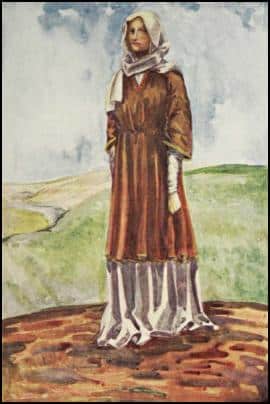
My comments are in italics.
Woman's Headdress - 1066
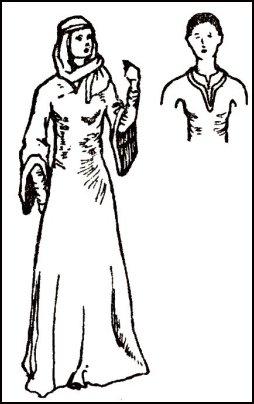
On the head, where the hair was closely coiled with a few curls at the forehead, a wimple was worn, which was wound about the head and thrown over the shoulder, not allowing the hair to show.
These wimples were sometimes very broad, and were almost like a mantle, so that they fell over the shoulders below the breast.
Tied round the wimple they sometimes had a snood, or band of silk.
A WOMAN OF THE TIME OF WILLIAM II - 1087-1100
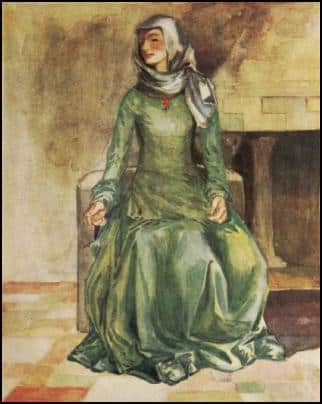
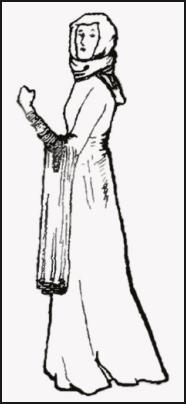
This shows a gown that fits far more closely to the female form. The sleeves gain width fullness above the wristline.
The large wimple was still worn wrapped about the head, and the hair was still carefully hidden.
A WOMAN OF THE TIME OF HENRY I - 1100-1135
Medieval Hair
This women's costume history illustration shows the pendant sleeve with an embroidered hem.
The long plaits of hair were held fast at the ends with metal, or silk tags. A white chemise is visible at the neck and wrists.
The greatest change in the appearance of the women was in the arrangement of the hair.
After a hundred years or more of head-cloths and hidden hair suddenly appears a head of hair. Until now a lady might have been bald for all the notice she took of her hair; now she must needs borrow hair to add to her own, so that her plaits shall be thick and long.
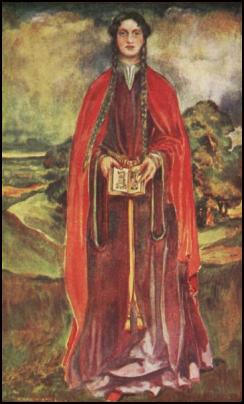
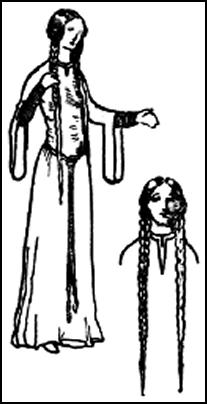
It is easy to see how this came about.
The Medieval hairstyles, for convenience, had always been plaited in two plaits and coiled round the head, where it lay concealed by the wimple.
One day some fine lady decides to discard her close and uncomfortable head-covering. She lets her plaits hang over her shoulders, and so appears in public.
Calthrop continues:-
Contempt of other ladies who have fine heads of hair for the thinness of her plaits; competition in thick and long hair; anger of ladies whose hair is not thick and long; enormous demand for artificial hair; failure of the supply to meet the ever-increasing demand; invention of silken cases filled with a substitute for hair, these cases attached to the end of the plaits to elongate them
- in this manner do many fashions arrive and flourish, until such time as the common people find means of copying them, and then my lady wonders how she could ever have worn such a common affair.
The gowns of these ladies remained much the same, except that the loose gown, without any show of the figure, was in great favour; this gown was confined by a long girdle.
The silk cases into which the hair was placed were often made of silk of variegated colours, and these cases had metal ends or tassels.
Medieval Hairstyles - Cases for the Hair
The hair was a matter of great moment and most carefully treated; it was parted in the centre and then plaited, sometimes intertwined with coloured ribbands or twists of thin coloured material; it was added to in length by artificial hair, and was tied up in a number of ways.
Either it was placed in a tight silk case, like an umbrella case, which came about half-way up the plait from the bottom, and had little tassels depending from it, or the hair was added to till it reached nearly to the feet, and was bound round with ribbands, the ends having little gold or silver pendants.

The hair hung, as a rule, down the front on either side of the face, or occasionally behind down the back, as was the case when the wimple was worn.
When the ladies went travelling or out riding they rode astride like men, and wore the ordinary common-hooded cloak.
The plait was introduced into the architecture of the time, as is shown by a Norman moulding at Durham.
Right - Cases for the Hair
A WOMAN OF THE TIME OF STEPHEN - 1135-1154
The dress has extra long sleeves and these have been tied up to keep them from trailing the ground.
She holds a green wimple in her hands and she was able to use that to cover up her luxuriant braided hair.
The plaited braids are fastened at the end into silken cases.
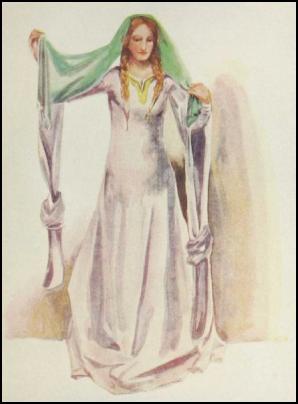
THE WOMEN - The Wimple
About this time came the fashion of the chin-band, and again the glory of the hair was hidden under the wimple.

Stages Of Dressing The Hair For A Chin Cloth
To dress a lady's hair for this time the hair must be brushed out, and then divided into two parts: these are to be plaited, and then brought round the crown of the head and fastened in front above the forehead.
The front pieces of hair are to be neatly pushed back from the forehead, to show a high brow.
Now a cloth of linen is taken, folded under the chin, and brought over the top of the head, and there pinned.

Then another thin band of linen is placed round the head and fastened neatly at the back; and over all a piece of fine linen is draped, and so arranged that it shall just cover the forehead-band and fall on to the shoulders.
This last piece of linen is fastened to the chin-band and the forehead-strap by pins.
The Linen Cap
This fashion gave rise in later times to a linen cap; the forehead-strap was increased in height and stiffened so that it rose slightly above the crown of the head, and the wimple, instead of hanging over it, was sewn down inside it, and fell over the top of the cap. Later the cap was sewn in pleats.
A WOMAN OF THE TIME OF HENRY II - 1154-1189
Although discreet its possible to just about see the chin band the 12th century woman wears in this costume plate. The chin-band passes under the wimple and the band is pinned to hold it around the head.
A WOMAN OF THE TIME OF RICHARD I - 1189-1199
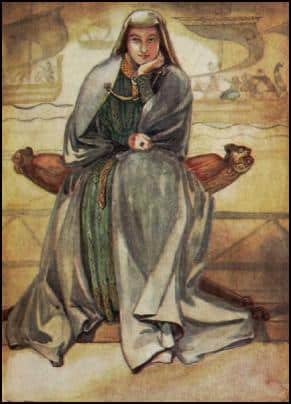
At the neck a large buckle holds the gown well together.
The hem and neck of the gown are richly embellished with embroidery and the gown overall is ornamented with a simple diaper pattern.
The wimples were pieces of silk or white linen held to the hair in front by pins, and allowed to flow over the head at the back.
There were still remaining at this date women who wore the tight-fitting gown laced at the back, and who tied their chins up in gorgets.
A WOMAN OF THE TIME OF JOHN 1199-1216

As may be seen from the plate, no change in costume took place.
The hair plaited and bound round the head or allowed to flow loose upon the shoulders. Over the hair a gorget binding up the neck and chin. Over all a wimple pinned to the gorget.
Right - Notice the glimpse of purse beneath the cloak front, where it hangs from the belt.
A fine diaper-patterned material has been used for the cloth of the cloak.
A WOMAN OF THE TIME OF HENRY III - 1216-1272
Right - This costume plates shows the very slight changes in a woman's dress. The woman wears a plain cloak, a plain gown, and a wimple over the head.
A lady would have worn clothes and shoes of richer cloth.
For the head a wimple made of white linen or perhaps of silk; this she would put above her head, leaving the neck bare.
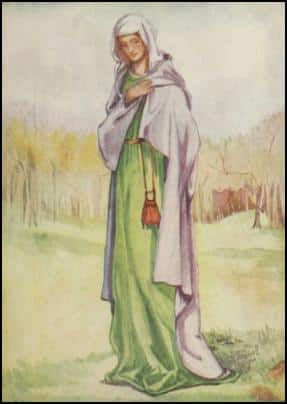
A WOMAN'S HEADWEAR OF THE TIME OF EDWARD I - 1272-1307
The Gorget

Calthrop continues to write:-
They sought for comfort in every particular but one: for though I think the gorget very becoming, I think that it must have been most distressing to wear.
This gorget was a piece of white linen wrapped about the throat, and pinned into its place; the ends were brought up to meet a wad of hair over the ears and there fastened, in this way half framing the face.
The hair was parted in the middle, and rolled over pads by the ears, so as to make a cushion on which to pin the gorget. This was the general fashion.
The Round Linen Cap
Now, the earlier form of head-dress gave rise to another fashion. The band which had been tied round the head to keep the wimple in place was enlarged and stiffened with more material, and so became a round linen cap, wider at the top than at the bottom.
Sometimes this cap was hollow-crowned, so that it was possible to bring the wimple under the chin, fasten it into place with the cap, and allow it to fall over the top of the cap in folds; sometimes the cap was solidly crowned, and was pleated; sometimes the cap met the gorget, and no hair showed between them.
WOMEN OF THE TIME OF EDWARD I - 1272-1307
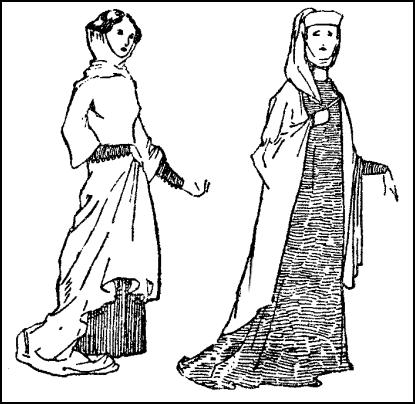
WOMAN OF THE TIME OF EDWARD II - 1307-1327
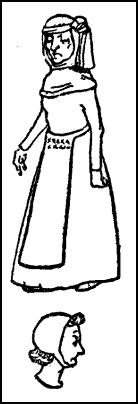
Left - Dressing the hair was important and the woman has her hair dressed in two side-plaits.
The throat gorget or neck-cloth has been pinned to her plaits.
Right - Gorget version worn by a common woman.
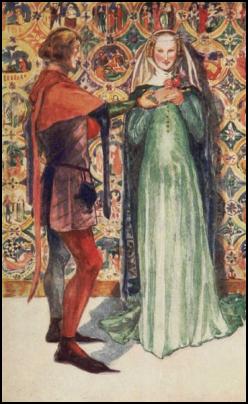
HEAD COVERINGS 1307-1327
Wimple, Gorget & Fillet

Upon the head they wore the wimple, the fillet, and about the throat the gorget.
The arrangement of the wimple and fillet were new, for the hair was now plaited in two tails, and these brought down straight on either side of the face.
The fillet was bound over the wimple in order to show the plait, and the gorget met the wimple behind the plait instead of over it.
The older fashion of hair-dressing remained, and the gorget was pinned to the wads of hair over the ears, without the covering of the wimple.
The Broad Wide Fillet Headdress 1307-1327
Sometimes the fillet was very wide, and placed low on the head over a wimple tied like a gorget; in this way the two side-plaits showed only in front and appeared covered at side-face, while the wimple and broad fillet hid all the top hair of the head.
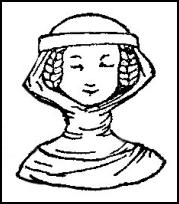
Steeple Headdress 1307-1327
Very rarely a tall, steeple head-dress was worn over the wimple, with a hanging veil; but this was not common, and, indeed, it is not a mark of the time.
Calthrop noted:- However, I have seen such a head-dress drawn at or about this time, so must include it.
This costume history page is about hair fashion history. It consists of a selection of women only headdresses and hairstyle illustrations and text from 1066 to 1327 all taken from Calthrop's English Costume. They are as shown in individual Calthrop costume pages for specific eras on 36 other pages in another section of this website. The partial text copy is from the book ENGLISH COSTUME PAINTED & DESCRIBED BY DION CLAYTON CALTHROP.
This page is about female headdresses and hairdressing styles for the medieval era 1066-1327. Later eras of headdresses are shown on other pages. For the Introduction to this book see this introduction written by Dion Clayton Calthrop.
My comments are in italics.
Page Added January 2011. Ref:-P.771
